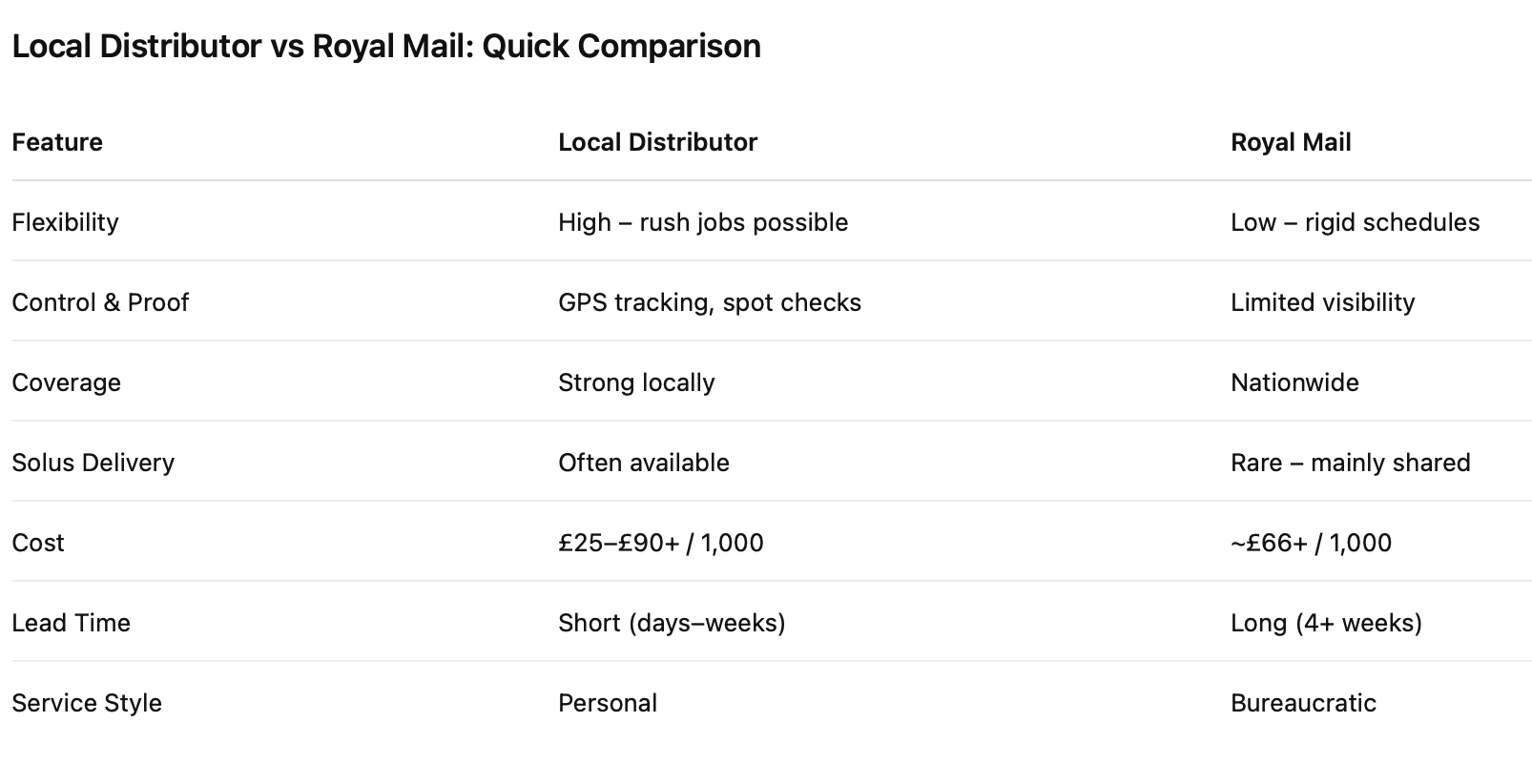- Home
- Leaflet Distribution
At Prestige Creative, we’ve helped many estate agents run successful leaflet campaigns across the UK. Over the years we’ve observed that the best results often come from working with a local, reliable distributor — someone you can hold accountable, adapt to your schedule, and build a long-term relationship with.
That said, Royal Mail’s “Door to Door” service is also an option, particularly for larger or more rural campaigns. Below we review the pros and cons of each approach, typical costs, and how to choose the right partner.
⸻
Pros
Flexibility & Speed – local teams can often handle short notice and last-minute changes.
Accountability & Oversight – you can meet them, inspect drops, and ask for GPS tracking or proof.
Tailored Targeting – they know the area, which roads perform best, and where to avoid.
Exclusivity – with regular monthly business you may be able to secure exclusivity in your patch.
Better Reporting – many now offer real-time mapping, GPS, and post-campaign reporting.
Cons
Coverage Limitations – they may only serve certain districts, so you may need multiple suppliers.
Variable Quality – some firms cut corners with underpaid delivery staff.
Scaling Issues – big campaigns (50,000 leaflets) may be beyond their resources.
Peak Season Delays – during busy periods, jobs can get pushed back.
⸻
Leaflet distribution costs vary depending on the area, density of housing, leaflet size and weight, and whether you choose solus (your leaflet only) or shared distribution (yours with others).
Shared distribution: around £25–£50 per 1,000 leaflets
Solus distribution: typically £50–£90 per 1,000, rising to £100–£160 in premium or rural areas
Royal Mail Door to Door: often quoted as £200 to reach ~3,000 homes (≈ £66 per 1,000)
Extras: GPS tracking, photographic proof, special packing, or delivery to depots will add cost
Sources:
⸻
Royal Mail offers an online booking tool where you select postcode areas, upload artwork, and send them your leaflets. They then deliver unaddressed flyers to households along their postal routes.
See the tool here: Royal Mail Drop a Leaflet.
Pros
Nationwide Coverage – virtually every UK postcode, including rural and hard-to-reach homes.
Trusted Brand – people recognise and trust Royal Mail delivery.
Scalable – ideal for very large campaigns.
Planning Support – the online tool provides household data by postcode and helps forecast reach.
Cons
Less Flexible – strict lead times; leaflets must be delivered to them weeks in advance.
Strict Packing Rules – boxes must be ≤10 kg and labelled precisely. Printers often charge extra for this.
Shared Delivery Only – your leaflet usually arrives bundled with others.
Lower Visibility & Control – no GPS tracking, limited campaign reporting, and ~10–20% of households may miss the drop.
Less Personal Service – harder to get quick responses or custom arrangements.
Further reading:
Mr Flyer – Is Royal Mail Better?
Dor2Dor – Drawbacks of Batch Delivery

When selecting a distributor, ask:
Do they provide GPS tracking or proof of delivery?
Will they agree exclusivity so no other estate agents are dropped in your patch?
What’s their minimum order and cost per 1,000 at your volume?
How do they handle hard-to-reach properties (gated drives, flats, dogs)?
Do they have references or case studies with other local businesses?
What are their hidden extras (packing, transport, insurance)?
Are they responsive and flexible to last-minute requests?
For estate agents distributing leaflets consistently every month, a trusted local distributor is usually the best choice: more flexible, more accountable, and easier to build a lasting partnership with. Royal Mail is a good option if you need nationwide coverage or want to reach rural postcodes that local teams struggle with.
⸻
Royal Mail are not flexible, they very much like to dot the i's and cross the t’s . You have to plan in advance, we suggest at least a month before you want he distribution to start because the printed leaflets need to be with them 2 weeks before distribution starts.
Royal Mail have specific packing requirements, the leaflets need to be in boxes less than 10kg which is smaller then what we would normally pack to and all boxes require labels.
.png)